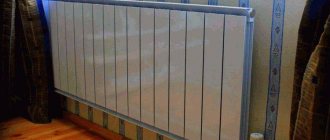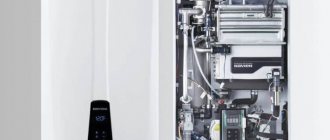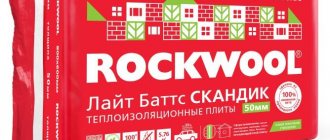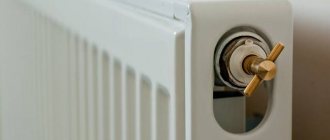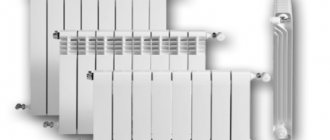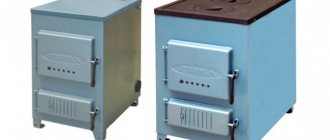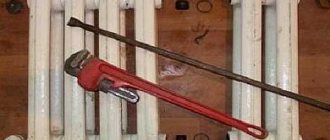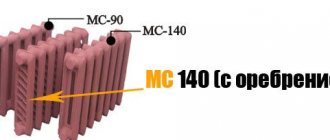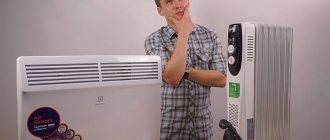Today there are more than five different types of radiators for home, office and other premises. They differ from each other in the material from which they are made, as well as in shape. Radiators are made of steel, cast iron, aluminum and bimetallic. They can be tubular, sectional or panel in shape. The battery material affects heat transfer, and the shape affects the circulation of warm air. The combination of these factors forms the climatic conditions in space. In this collection we will look at cast iron radiators.
Modern technologies and design solutions have made it possible to breathe new life into these devices. If previously they had a very unattractive appearance, today you can choose a model for almost any interior. In addition, they have the longest service life, which averages about 50 years. Cast iron batteries can withstand very high water pressure, allow most of the heat to be transferred not through convection, but through thermal radiation, and are practically not subject to corrosion. The devices are connected to the central heating system in apartment buildings, and if we are talking about a private building, then there is a need to lay a main line. All these features make them very competitive in the radiator market. However, they also have a number of disadvantages. In particular, it is heavy, difficult to assemble and install, as well as difficult to clean between sections.
Dimensions of heated towel rails What size of heated towel rail is optimal
Komsomolskaya Pravda analyzed offers on the device market and compiled a top 10 rating of the best.
The main types of Conner brand radiators: cast iron batteries
“Conner” is a radiator that is sold in cast iron products.
They are intended for systems with natural or forced water circulation. This heating equipment breaks past stereotypes, as it has high quality workmanship. These devices meet aesthetic and technical requirements, so they could become a highly efficient addition to heating systems. It is impossible not to note the affordable cost, as well as durability, corrosion resistance and immunity to any type of coolant. This also applies to water quality. “Conner” is a cast iron radiator that is ready to last up to 50 years. It can be used in high-rise buildings, or more precisely in heating systems that operate under high pressure. Due to the fact that the devices have low hydraulic resistance, they can be used in systems with natural circulation. Such products become even more versatile due to the different diameters of the inlet pipes. The components are supplied with the device, which is certified and fully complies with state standards.
Some general information
A heating radiator, commonly referred to as a battery, can be made of the following materials: steel, cast iron, aluminum, copper, etc. But we will only talk about cast iron. Its main advantages are that corrosion processes proceed extremely slowly. It is for this simple reason that not a single heating radiator has yet surpassed cast iron in durability. Another important advantage is high heat transfer. For example, your heating has been turned off. In this case, a cast iron battery will heat up much longer than a steel or aluminum one. But this is not all that cast iron heating radiators can boast of. The technical specifications here are also excellent. Water hammer, critical pressure drops in the system, or poor quality of the coolant, which are destructive to copper or aluminum products, are not scary.
All of the above advantages indicate that this is an excellent solution for heating a room. “But everything can’t be so perfect!” - you say. Of course, cast iron radiators also have their disadvantages. For example, it is difficult to imagine something heavier than a battery made of this metal. Another disadvantage is the design, which often does not fit modern interiors. But this problem is being partly solved; more and more original models in retro or modern style are appearing on the markets. Let's look at cast iron heating radiators, which are better and which are not worth your attention.
Characteristics of aluminum radiators of the Conner brand
If Conner cast iron radiators are not suitable for you, you can consider aluminum ones, which, according to users, are durable, lightweight and have an incomparable design. The devices have a high elegance of execution, and work quite efficiently, with increased heat transfer. Consumers also note the high reliability of these batteries.
Conner cast iron radiators may seem quite expensive to some consumers. But aluminum models have an acceptable cost, and they can be made using casting technology or the extrusion method. The depth of these devices can be 70 and 100 mm. The circular cross-section of the collector, the use of composite glue, and the installation of connections by laser welding allow the radiators to withstand high pressure. If we are talking about cast aluminum radiators, then their depth can vary from 80 to 100 mm. The average value is 85 mm. The center distance is 500 mm.
Reviews of aluminum models
“Conner” is a radiator that is also offered by the manufacturer in the form of aluminum devices. Consumers especially emphasize that when purchasing these devices, it is necessary to pay special attention to ensure that the product is not defective. This is because some buyers face such problems. It would be good if there was an opportunity to exchange the device. After only 3 years, these units leak in some apartments, but you can still use service support under warranty.
If Konner radiators will be installed within the same room, then you should consider whether their shades and appearance match. In some cases, the models differ from each other, despite the fact that the boxes are exactly the same.
Reviews of Konner brand bimetallic radiators
Konner bimetallic radiators are the most innovative development in this area. They are manufactured taking into account operating conditions in Russia. The design is very durable, which is ensured by the presence of an internal collector. According to buyers, it is made of high-alloy steel, which makes the components resistant to corrosion. This feature eliminates contact between the coolant and water, which is why bimetallic devices are able to work together with any coolant. As buyers emphasize, it does not matter at all what the acid-base balance is.
During the manufacturing process, these devices are tested, and at the final stage they are coated with epoxy enamel. Users really like this, since this approach allows it to maintain its original properties and the surface does not compromise its integrity throughout its entire service life, while it remains resistant to ultraviolet radiation.
Corrosion resistance level
The average values are presented in the table.
| Corrosion resistance (mm/year) of cast iron | |||||||||
| Cast iron | terms of Use | ||||||||
| Industrial environment | Chamber with 0.3% SO2 additive | Sheath liquid at 25 °C | Sea water* | 10% at 50 °C | 3% at 10-19 °C | 5% acid | |||
| sulfuric | salt | nitrogen | |||||||
| White | — | — | — | 0,05 | — | — | — | — | — |
| Grey | 0,14 | 0,24 | 0,27 | 0,06 | 0,02 | 0,08 | 31 | 27 | 26 |
| Lasting | — | — | — | — | — | — | — | — | — |
| ferrite | 0,18 | 0,29 | 0,22 | 0,06 | 0,01 | 0,08 | — | — | — |
| ferrite and pearlite | 0,18 | 0,24 | 0,26 | — | — | 0,08 | — | — | — |
| perlite | 0,14 | 0,22 | 0,29 | 0,06 | 0,01 | 0,08 | — | — | — |
| Malleable | — | — | — | 0,06 | — | — | — | — | — |
| Corrosion-resistant type 4N 15D7 | — | — | 0,05 | 0,02 | — | — | 0,15 | 0,3 | 21 |
| Silicon ChS 15 | — | — | — | — | — | — | 0,13 | 0,13 | — |
| *when tested in running water, corrosion is higher. The rate is 1 g/(m2∗h) = 1.2 mm/year. |
Negative reviews of Konner brand cast iron radiators
Heating radiators "Conner", as mentioned above, can be bimetallic, aluminum or cast iron. The latter will be discussed in this section. Some consumers argue that this purchase cannot be called profitable, since the quality makes itself felt during operation. Externally, such batteries look aesthetically attractive, look stylish, the heat dissipation, according to the supplier, is excellent and reaches 150 W from each section.
Consumers claim that the installation is successful in any case, without difficulty and quite quickly. But after starting the heating, the most unpleasant things begin. The rooms are cold, the stated figures turn out to be just a publicity stunt. The temperature does not rise above 23 °C. Some, choosing cast iron heating radiators, the price of which will be mentioned below, then change them to traditional aluminum ones. From this we can conclude that it is necessary to become more familiar with the qualitative characteristics of these devices before purchasing, as well as correctly calculate the heat capacity.
Installation and operation rules
The campaign recommends entrusting installation to professionals. In this case, before installation, it is necessary to tighten the nipple nuts, which may become loose during transportation. When installing radiators under a window or in a niche, for normal heat transfer, the following distances must be observed:
- from the top edge of the niche or from the window sill - 10 cm;
- from the floor - 10 - 12 cm;
- from the wall to the back panel - 3 - 5 cm.
It is desirable to install shut-off valves (ball valves) at the inlet and outlet of the radiator; a manual or automatic air vent is required on each device. Installation of control valves is possible.
Once every 4-5 years, preventive cleaning is necessary: dirt and sludge can accumulate in radiators, which impair circulation and reduce heat transfer. To do this, use ball valves to turn off the supply, unscrew and remove the batteries. Then rinse with water (it is possible to use special products).
Price
If you decide to purchase Konner cast iron radiators, then you should pay attention to the cost of one section, which is limited to 430 rubles. In this case, we are talking about the Modern 500 device, the heat capacity of which is 150 W per section. If you prefer 4 sections, the power will be 600 W, and the cost will increase to 1,720 rubles. Cast iron heating radiators, the price of which reaches 6,450 rubles, can have a heat capacity of 2,250 W. In this case, the number of sections will be 15. It is worth noting that this equipment is manufactured by injection molding, which is most often preferred by modern consumers.
If you do not need such heat capacity, then you can choose a device whose one section produces 120 W. Thus, for the “Modern 300” model you will have to pay 420 rubles, whereas if the heat capacity increases to 1800 W, and the number of sections increases to 15, the cost is already 6300 rubles.
How to choose cast iron heaters
When choosing radiators, we follow the standard algorithm. We determine the required thermal power, calculate the number of sections, and assemble heating devices for each room from them. Then - the purchase of heaters, installation kits and control valves.
What type of radiators is better to choose:
- For heating technical, utility and utility rooms of a private house, the MS-140M series or its variants are quite suitable.
- In residential premises, “accordions” are clearly inappropriate. Buy nicer “aluminum-look” batteries.
- If your budget allows, install designer appliances - domestic or imported, there is practically no difference.
Find out the weight of the sectional heater in advance and consider the installation method - wall or floor. Vintage taps for retro batteries by Carlo Poletti - Conventional ball valves and balancing valves are not suitable for retro radiators purely visually. We need similar Carlo Poletti fittings.
- Place any batteries you like in a private cottage; they will easily withstand the pressure of an autonomous system.
- What devices are best for an apartment? The answer depends on the method of heat supply. With a centralized supply, it is not recommended to install cast iron due to periodic testing of the network. If the pressure “jumps” to 12 bar, the sections may crack.
Cast iron radiators Konner: buy a great option for your home or apartment
The modern market offers a variety of options and models of cast iron batteries. The Conner brand is no exception, presenting several models of high-quality cast iron batteries for the buyer to choose from. All of them have excellent characteristics, a high level of corrosion resistance, but differ in appearance and technical parameters.
Conner Modern
This model is easy to distinguish by its external parameters. Exquisite white sections, somewhat reminiscent of standard aluminum radiators, fit perfectly into any interior. The ruler is presented in two options for the center distance - 300 and 500 mm. In this case, the size of the largest section is 600x64x100 mm. The power of the 300 model is 120 W, and the 500 is 150 W. Despite the fact that cast iron radiators are heavy, the weight of the largest section does not exceed 5 kg.
Cast iron radiators Konner Modern
allow you to forget about the stereotype - bulky and ugly batteries that cannot be hidden under decor. This product does not require any manipulation. An even coating of thermal paint allows you to forget about additional processing of the product forever. In addition, the option will perfectly complement even a designer interior.
Conner Heath
One of the variations of the previous model, but with more compact dimensions. With an interaxial distance of 300 mm, the section size is 365x60x80. These figures make it easy to place the battery even in a small space between a low window sill and the floor, and also save coolant costs for heating a small room.
As for the 500 model, its dimensions are similar to the Modern, and are 365x60x80 mm. At the same time, its appearance is somewhat different, and its technical characteristics are slightly inferior. But when choosing this model, you should take into account that its weight is slightly less, which will simplify installation and reduce the load on the wall.
Conner Legend
This radiator seems to have evolved from the usual cast iron models. It has an exceptional black color and is only available on the market in large sizes. High power and large dimensions are the main features of the line. The dimensions of the section with an interaxial distance of 600 mm are 707x72x140 mm. But the power of the product is at the appropriate level - up to 180 W per section.
The advantages of the model include a huge selection of designs, decorated with artistic forging and other elements. This model has only a side connection option, so it is not suitable for hidden heating systems.
Features of sectional heating devices
Sectional batteries from Konner are individual elements in a molded, ribbed or other design. The elements are equipped with one channel vertically, two channels horizontally, and are tightened with steel nipples. They are made of bimetal, cast iron and aluminum. To ensure coolant circulation, they have special seals.
The standard set has 10 sections, but the manufacturer mainly produces modifications for 4, 6, 8 and 12 battery sections. Conner sectional structures have several advantages:
- the possibility of increasing thermal power by adding one or several elements;
- replacing only the damaged section in case of leakage or damage;
- good maintainability;
- dividing one radiator into heating devices for several rooms;
- high heat transfer, providing savings on utilities.
To install the products yourself, you will need brackets, locknuts, a special seal and various connectors.
Cast iron radiator Konner Modern, Hit and Legend: advantages and disadvantages
The combination of obvious advantages and availability of this type of battery, supported by the high quality of modern products, made them popular among domestic consumers, accustomed to the reliability of cast iron and its durability.
Conner cast iron batteries have a number of advantages:
- The natural resistance of cast iron to corrosion makes it possible to use absolutely any type of coolant. Even bad water used in centralized systems will not affect the quality of work.
- The high resistance of the material ensures up to 50 years of uninterrupted radiator service. They are not afraid of pressure changes, so they do not require routine repairs for a long time.
- A standard connection will allow you to handle the installation yourself. The device does not require special skills and abilities, so the buyer, if he has a basic set of tools, can replace the battery himself.
- The structure of the channels allows the radiator to be used in systems even without an installed circulation pump. The coolant moves unhindered equally well in systems with forced and natural circulation.
- The high level of heat transfer is why everyone loves cast iron. It allows you to get the most out of your heating system, retaining heat for a long time even when the heating is turned off.
- The surface does not consist of the usual ribs, but of plates, which increases heat transfer.
In addition to the listed advantages, batteries have a number of disadvantages - the fragility of the metal and its heavy weight. Therefore, these points must be taken into account during transportation and installation. Improper installation may result in the radiator not being able to hold on, and if dropped, it may simply crack.
Konner Modern - cast iron radiators, which can be purchased in our online store. In the catalogs you will find not only this model, but also a wide selection of other representatives of this brand. There is something for everyone who loves classic or modern style. If you have any questions, we advise you to contact our managers. They will help you choose the most suitable option, make a purchase and a convenient delivery method.
Results
In cases with cast iron during normal casting, the reliability of the operation of heating radiators is determined by the quality of the gaskets and nipples. Cast iron from the Conner company has defects, its quantity is 1% of the total mass. The quality of the gaskets and nipples is fine. When installing, you must follow the manufacturer's recommendations and check that the connections have not become loose during transportation. In general, there was an opinion that in recent years the quality of Konner’s products has become worse: there are more defects in painting and there are even burrs on aluminum radiators, which should not happen at all.

